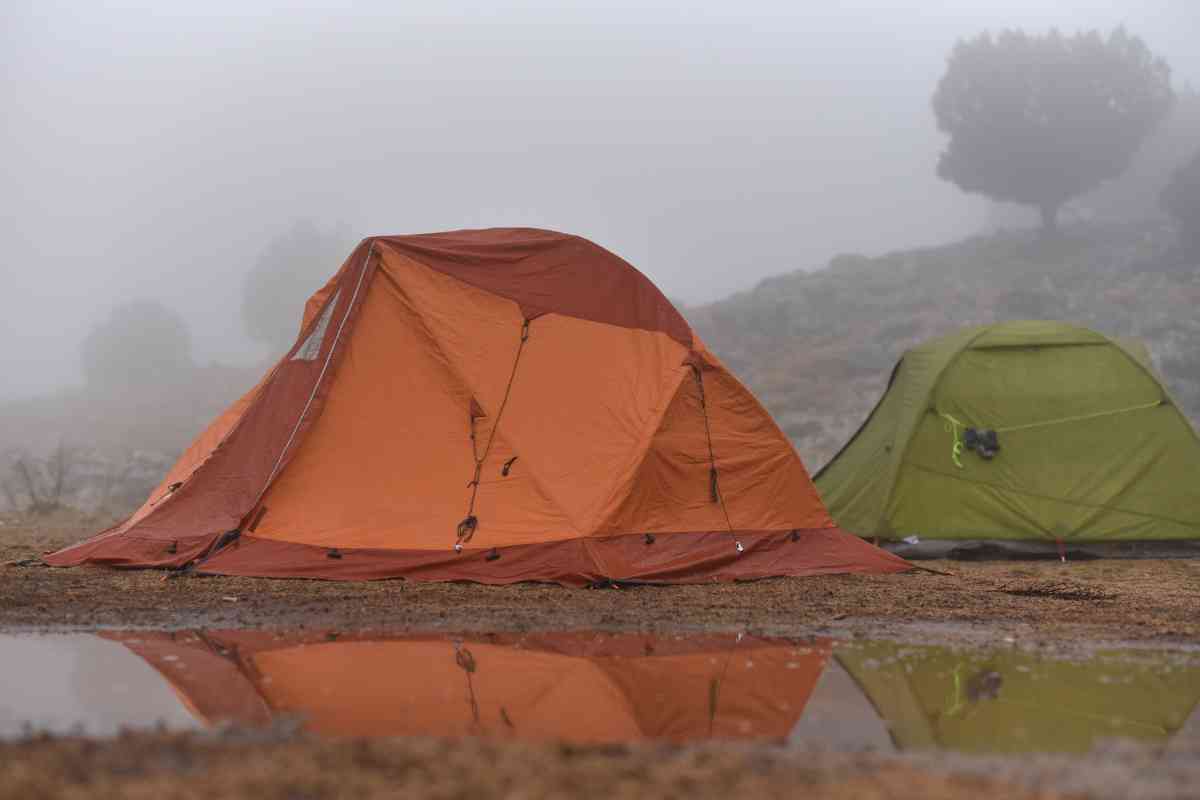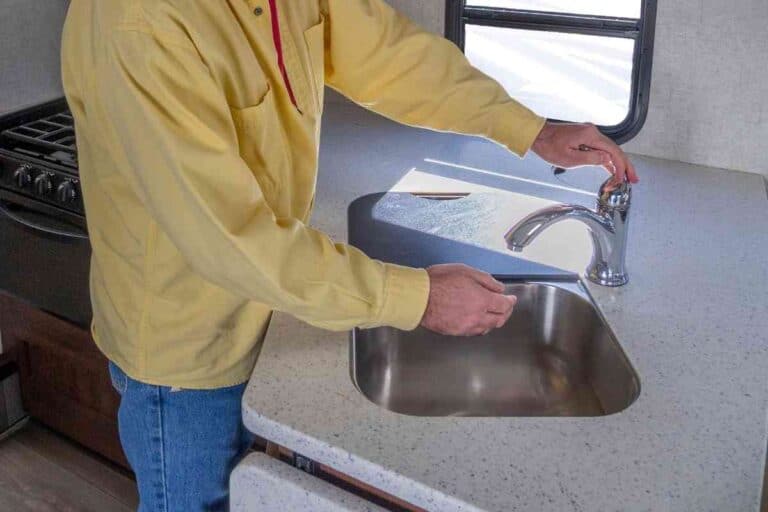7 Ways To Dry A Tent – Fast And Easy!
Anyone who has ever got caught in an overnight camping rainstorm is going to ask themselves this question…how do I dry my tent after a big rainstorm?

What’s the best way to dry a tent?
Here are 7 ways to dry a tent that are quick and easy:
- Towel dry the tent
- Let the sun do the work for you
- Air it out before you pack it
- Pack it lightly
- Lay it out when you get it home
- Blow dry it
- Prepare it for the next trip
Recently, I got caught in a rainstorm while camping. Believe me, it wasn’t fun for me or the good sports that were along for the ride.
By the time we got home, everything was soaked, and needed to be dried out. The good news, though, is that I had done my research and knew what needed to be done to dry out our tent before I stored it for the next (hopefully drier!) camping trip we would all embark on.
Here Are the 7 Ways to Dry a Tent That Are Quick and Easy
Tents have been around for hundreds of years. Though no one knows exactly when tents were first invented, we know that some sort of shelter has been used from the beginning of time.
People have always needed a way of providing themselves with a way of shelter and tents are the perfect way to do this.
It wasn’t until the 1960s that tent camping really exploded in popularity. Until then, people who used tents did it more for function and purpose, not for fun like we do today.
But the 60s saw a time of camping that was not just out of necessity, but also for fun. Camper vans became a big part of the way people wanted to live and eventually living out of a tent became just as popular, if not more so.
There are still plenty of folks out there that don’t get the appeal of tent camping. They think that “roughing it” is going to be too taxing – mentally, physically, and just time-wise.
But those of us who love tent camping will disagree with all of that. Pitching a tent – whether it’s in your backyard, in a campsite, or on a trail somewhere is one of the most rewarding experiences for anyone who likes the great outdoors.
It’s hard to explain why.
Maybe just the sense of accomplishment? Or the realization you can provide shelter for yourself and the people you love, regardless of the situation?
Regardless of the reason, tent camping doesn’t have to be complicated. The most important elements are that a tent is waterproof, windproof, easy to assemble, and easy to take apart and eventually store.
So…assuming you’ve covered those main elements, there’s not a lot left to worry about.
But – drying a tent can be a real nuisance. Especially when the size, the weather, and your amount of time are all factored in.
Depending on your budget and your lifestyle, some of these factors may change.
But for the most part, the basics of drying a tent are pretty much…basic.
From the time I was a small child, I have always loved hanging out in a tent. Whether it was camping with my family, or convincing my dad to pitch a tent in the backyard for my friends and me, there is something about a tent that pulls at all of us and makes us think about simpler times. Knowing how to dry a tent when Mother Nature calls for it is a skill you won’t soon forget.
Let’s look at the 7 best ways to dry a tent and how to make sure your tent is ready for its next outdoor experience.

1. Towel Dry the Tent
When your tent is soaking wet, but it’s time to pack up, you may be wanting to find some way to get at least some of the excess moisture off before you roll it up and put it in your car, truck, or van.
Especially if you have a decent drive ahead of you, getting as much excess water off the tent as possible will help keep any mold from starting to set in.
And it will be more pleasant to unpack later.
Though any sort of towel will work to remove water from the outside (and inside) of your tent, it may be worth investing in some microfiber towels to have handy, particularly if you’re a regular camper and plan on spending a decent amount of time out in the great outdoors.
Microfiber towels are great for wicking away water, and the store easily too.
The good news is, having a few microfiber towels on hand means you’ll be prepared for any type of wet weather or spills. You can also use them for bathing, washing hands, and faces, or washing dishes as well.
2. Let the Sun Do the Work
Probably the easiest and quickest way to dry your tent is going to be by letting Mother Nature do the work.
Assuming it’s not still raining when you’re packing up, letting your tent just bake in the sun a bit will cause most of the moisture to evaporate.
Even a tent that got soaked the night before will begin to dry out relatively quickly once the bright rays of the next day work their magic.
Make sure you put the tent somewhere so that the full sun can get to all sides of it. You may need to turn it so each side gets the full sun’s effect.
If the inside is also wet, turn the tent inside out, and let the sun dry out the inside first. Then you can go ahead and let the sun’s rays warm up the outside enough to dry it out as well.
3. Air it Out
If you’ve woken up the next day after a good hard rain and the skies are still cloudy, the sun may not peek out enough to fully dry your tent before you have to pack it up and head out.
If this is the case, see if you can at least leave it out long enough to let some air circulate around it and start to dry some of the moisture.
The good news is, most tents are made to dry pretty quickly. Since the main materials are typically a nylon/polyester blend, they are naturally designed to wick water off their surface pretty fast.
So, sometimes just a good air dry for a couple of hours will do most of the work for you. Then you can finish drying it when you get home.
4. Pack It Lightly
It can be tempting to want to tightly reroll a tent after using it. Maybe space is tight in your vehicle, or you just don’t want to deal with your tent flopping all over the place, especially if it’s still wet and you don’t want it getting everything else wet as well.
That said, you’ll be better off later if you pack your tent loosely before heading out. Allowing it some space to dry while you’re driving will help evaporate some of the remaining water, especially if you have some air circulating around it.
And – though mildew and mold usually take a few days to set in on a wet surface, a wet tent that’s tightly packed could start to encourage a few spores to begin to grow.
If you have the space, let your tent have some extra room in the back of your car, truck, or van until you can get it to a place to really air it out.
5. Let It All Hang Out!
Once you get to a place where the ground is dry and the sun is out, give your tent a good chance to fully dry out.
After any camping trip – even ones where rain wasn’t a problem – I like to lay my tent out on the driveway or a dry spot on my grass.
I will usually leave it there for an hour and then flip it over, letting all sides get a proper amount of air and sunshine before I pack it away.
There’s nothing worse than opening a tent and realizing that the last time you used it, it didn’t dry properly. The smell can be pretty unpleasant and the mildew and mold will certainly have had a chance to grow by then.
6. Blow Dry It
If your tent is really soaked, or you simply don’t have the space to let it air out, using a hair dryer or leaf blower can also help speed things along.
This is also a great option if you don’t have tons of time and want to dry it out quickly.
Water evaporates fast when it’s exposed to any sort of air, so creating some of your own when Mother Nature isn’t helping can definitely help do the trick.
If you do decide to use a hair dryer or leaf blower, just be careful not to hold it too close to the tent to cause any burning or other damage. Also, be aware that water and electricity don’t mix, so keep any cords away from spots that are particularly damp.
7. Prepare It for Next Time
Finally, once everything is nice and dry, spend a bit of time thinking ahead for the next camping trip.
Even though tents are naturally designed to be waterproof (or at least water repellent) you may want to apply another layer of sealant just to give it some extra protection for next time.
There are a number of good waterproofing sealants on the market. Most are applied with a spray bottle or a rag.
Sealants are also handy for your other camping gear that tend to get wet. It’s a good idea to be in the habit of re-waterproofing all your camping gear at least once a season to make sure it’s ready for anything that Mother Nature throws at it.
Key Takeaways
- It wasn’t until the 1960s that tent camping really became popular and was something people did for recreation.
- Most tents are made of materials that are designed to get wet, such as nylons and polyesters.
- When you need to dry out your tent, there are several ways to do it, such as towel dry it, let the sun do the work, air it out, pack it lightly, hang or lay it out when you get home, blow dry it and prepare it for the next camping trip.




![How To Reset A PUR Filter [Solved In Seconds!]](https://freedomresidence.com/wp-content/uploads/2022/06/How-To-Reset-A-PUR-Filter-768x512.jpg)

![Are Log Cabins High Maintenance? [Tips For A Long Life!]](https://freedomresidence.com/wp-content/uploads/2022/05/Are-Log-Cabins-High-Maintenance-1-768x512.jpg)